The Right Activities at Right Spaces: Relationships between Elderly Adults’ Physical Activities and Thermal Responses
Abstract
1. Introduction
2. Methods
2.1. Study Area
2.2. Experimental Design
2.2.1. Types of Horticulture Activities
2.2.2. Experimental Procedures
2.2.3. Questionnaire Survey
2.3. Measurements
2.3.1. Physiological Measurements
2.3.2. Meteorological Measurements
2.4. Thermal Indices and Statistical Analysis
3. Results
3.1. Descriptive Analysis
3.1.1. Attributes of Volunteers
3.1.2. Meteorological Parameters
3.2. TSV and TCV
3.2.1. TSV
3.2.2. TCV
3.3. NPET and NPETR
3.4. Physiological Responses
3.4.1. Physiological Parameters
3.4.2. Physiology and Metabolic Rate
3.5. Relationship between Physiological Parameters and Thermal Comfort
4. Discussion
4.1. Physiological and Thermal Responses
4.2. Bioclimatic Design Recommendations
4.3. Limitations
5. Conclusions
- (1)
- Changes in the proportions of the TSV and TCV before and after activity were related to spatial characteristics and metabolic levels of outdoor activities in summer. The OS space had a significantly higher discomfort and TSV after vigorous-intensity horticultural activity due to high Ta and G (the proportion of “warm” increased by 33.33% and the proportion of “very comfortable” decreased by 16.67%); whereas the TS space showed little change in thermal responses before and after horticultural activities at three levels.
- (2)
- Before and after the low-intensity horticultural activity (flower arrangement), the physiological indices remained constant. However, there were significant differences in SBP, DBP, HR, and SpO2 before and after moderate and vigorous-intensity horticultural activities (transplanting and planting; laying crushed stone).
- (3)
- HR and diastolic blood pressure can reflect the changes in metabolic rate in the elderly. As the metabolic rate gradually increased, the HR and diastolic blood pressure both increased.
- (4)
- During horticultural activities, the neutral temperature was negatively correlated with the activity intensity, whereas the magnitude of the neutral temperature change was positively correlated with the activity intensity. NPET ranged from 21.45 to 29.73 °C and NPETR from 13.27–29.64 to 24.94–34.56 °C. In addition, the MTSV sensitivity decreased after low-to-moderate-intensity horticultural activities, whereas the opposite occurred after vigorous-intensity horticultural activities.
- (5)
- For the elderly in summer, semi-open spaces (TS spaces) were more suitable for outdoor horticultural activities. However, the PA and OS spaces were only suitable for low-to-moderate-intensity horticultural activities.
Author Contributions
Funding
Institutional Review Board Statement
Informed Consent Statement
Data Availability Statement
Conflicts of Interest
Nomenclature
| TSV | Thermal sensation vote | NPET | Neutral PET |
| MTSV | Mean TSV | NPETR | Neutral PET range |
| TCV | Thermal comfort vote | SBP | Systolic blood pressure |
| Ta | Air temperature | DBP | Diastolic blood pressure |
| RH | Relative humidity | HR | Heart rate |
| Va | Wind speed | SpO2 | Blood oxygen saturation |
| G | Global radiation | FoA | Flower arrangement |
| Tg | Globe temperature | TaP | Transplanting and planting |
| Tmrt | Mean radiant temperature | LcS | Laying crushed stone |
| PET | Physiological equivalent temperature |
References
- World Health Organization. Ageing and Health. 2021. Available online: https://www.who.int/news-room/fact-sheets/detail/ageing-and-health (accessed on 24 January 2022).
- United Nations. World Population Ageing. 2017. Available online: https://www.un.org/development/desa/pd/content/world-population-ageing-2017-highlights (accessed on 23 January 2022).
- Egger, G.; Dixon, J. Beyond Obesity and Lifestyle: A Review of 21st Century Chronic Disease Determinants. BioMed Res. Int. 2014, 2014, 731685. [Google Scholar] [CrossRef] [PubMed]
- Srivastava, I.; Thukral, N.; Hasija, Y. Genetics of Human Age Related Disorders. Adv. Gerontol. 2015, 28, 228–247. [Google Scholar] [PubMed]
- Khademi, N.; Babanejad, M.; Asadmobini, A.; Karim, H. The Association of Age and Gender with Risk Factors of Noncommunicable Diseases among Employees in West of Iran. Int. J. Prev. Med. 2017, 8, 9. [Google Scholar] [CrossRef] [PubMed]
- Jaul, E.; Barron, J. Age-Related Diseases and Clinical and Public Health Implications for the 85 Years Old and Over Population. Front. Public Health 2017, 5, 335. [Google Scholar] [CrossRef] [PubMed]
- Lewis, E.D.; Wu, D.; Meydani, S.N. Age-associated alterations in immune function and inflammation. Prog. Neuro-Psychopharmacol. Biol. Psychiatry 2022, 118, 110576. [Google Scholar] [CrossRef] [PubMed]
- Suzman, R.; Beard, J.; Boerma, T.; Chatterji, S. Health in an ageing world—What do we know? Lancet 2015, 385, 484–486. [Google Scholar] [CrossRef]
- World Health Organization. Global Status Report on Noncommunicable Diseases 2010; WHO: Geneva, Switzerland, 2011. Available online: https://apps.who.int/iris/handle/10665/44579 (accessed on 24 January 2022).
- Dahlkvist, E.; Hartig, T.; Nilsson, A.; Högberg, H.; Skovdahl, K.; Engström, M. Garden greenery and the health of older people in residential care facilities: A multi-level cross-sectional study. J. Adv. Nurs. 2016, 72, 2065–2076. [Google Scholar] [CrossRef]
- Berg, M.E.L.V.D.; Winsall, M.; Dyer, S.M.; Breen, F.; Gresham, M.; Crotty, M. Understanding the Barriers and Enablers to Using Outdoor Spaces in Nursing Homes: A Systematic Review. Gerontologist 2020, 60, e254–e269. [Google Scholar] [CrossRef]
- Chodzko-Zajko, W.; Schwingel, A.; Park, C.H. Successful Aging: The Role of Physical Activity. Am. J. Lifestyle Med. 2008, 3, 20–28. [Google Scholar] [CrossRef]
- Ma, X.; Tian, Y.; Du, M.; Hong, B.; Lin, B. How to design comfortable open spaces for the elderly? Implications of their thermal perceptions in an urban park. Sci. Total. Environ. 2021, 768, 144985. [Google Scholar] [CrossRef]
- Mi, J.; Hong, B.; Zhang, T.; Huang, B.; Niu, J. Outdoor thermal benchmarks and their application to climate–responsive designs of residential open spaces in a cold region of China. Build. Environ. 2020, 169, 106592. [Google Scholar] [CrossRef]
- Niu, J.; Xiong, J.; Qin, H.; Hu, J.; Deng, J.; Han, G.; Yan, J. Influence of thermal comfort of green spaces on physical activity: Empirical study in an urban park in Chongqing, China. Build. Environ. 2022, 219, 109168. [Google Scholar] [CrossRef]
- Gardener, M.A.; de Oliveira, F.L. Urban environment cues for health and well-being in the elderly. Cities Health 2020, 4, 117–134. [Google Scholar] [CrossRef]
- Powell, L.; Felce, D.; Jenkins, J.; Lunt, B. Increasing engagement in a home for the elderly by providing an indoor gardening activity. Behav. Res. Ther. 1979, 17, 127–135. [Google Scholar] [CrossRef] [PubMed]
- Machida, D. Relationship between Community or Home Gardening and Health of the Elderly: A Web-Based Cross-Sectional Survey in Japan. Int. J. Environ. Res. Public Health 2019, 16, 1389. [Google Scholar] [CrossRef]
- Veldheer, S.; Tuan, W.-J.; Al-Shaar, L.; Wadsworth, M.; Sinoway, L.; Schmitz, K.H.; Sciamanna, C.; Gao, X. Gardening Is Associated with Better Cardiovascular Health Status Among Older Adults in the United States: Analysis of the 2019 Behavioral Risk Factor Surveillance System Survey. J. Acad. Nutr. Diet 2022. [Google Scholar] [CrossRef]
- Detweiler, M.B.; Sharma, T.; Detweiler, J.G.; Murphy, P.F.; Lane, S.; Carman, J.; Chudhary, A.S.; Halling, M.H.; Kim, K.Y. What Is the Evidence to Support the Use of Therapeutic Gardens for the Elderly? Psychiatry Investig. 2012, 9, 100–110. [Google Scholar] [CrossRef]
- Park, S.-A.; Lee, A.-Y.; Park, H.-G.; Lee, W.-L. Benefits of Gardening Activities for Cognitive Function According to Measurement of Brain Nerve Growth Factor Levels. Int. J. Environ. Res. Public Health 2019, 16, 760. [Google Scholar] [CrossRef]
- Chu, H.-Y.; Chan, H.-S.; Chen, M.-F. Effects of Horticultural Activities on Attitudes toward Aging, Sense of Hope and Hand–Eye Coordination in Older Adults in Residential Care Facilities. Int. J. Environ. Res. Public Health 2021, 18, 6555. [Google Scholar] [CrossRef] [PubMed]
- Ainamani, H.E.; Gumisiriza, N.; Bamwerinde, W.M.; Rukundo, G.Z. Gardening activity and its relationship to mental health: Understudied and untapped in low-and middle-income countries. Prev. Med. Rep. 2022, 29, 101946. [Google Scholar] [CrossRef] [PubMed]
- Zhao, X.; Yu, J.; Liu, N. Relationship between specific leisure activities and successful aging among older adults. J. Exerc. Sci. Fit. 2023, 21, 111–118. [Google Scholar] [CrossRef] [PubMed]
- Park, S.-A.; Lee, A.-Y.; Park, H.-G.; Son, K.-C.; Kim, D.S.; Lee, W.L. Gardening Intervention as a Low- to Moderate-Intensity Physical Activity for Improving Blood Lipid Profiles, Blood Pressure, Inflammation, and Oxidative Stress in Women over the Age of 70: A Pilot Study. HortScience 2017, 52, 200–205. [Google Scholar] [CrossRef]
- Daffu, G.; Del Pozo, C.H.; O’Shea, K.M.; Ananthakrishnan, R.; Ramasamy, R.; Schmidt, A.M. Radical Roles for RAGE in the Pathogenesis of Oxidative Stress in Cardiovascular Diseases and Beyond. Int. J. Mol. Sci. 2013, 14, 19891–19910. [Google Scholar] [CrossRef]
- Tu, P.-C.; Cheng, W.-C.; Hou, P.-C.; Chang, Y.-S. Effects of Types of Horticultural Activity on the Physical and Mental State of Elderly Individuals. Int. J. Environ. Res. Public Health 2020, 17, 5225. [Google Scholar] [CrossRef]
- Yamane, K.; Kawashima, M.; Fujishige, N.; Yoshida, M. Effects of Interior Horticultural Activities with Potted Plants on Human Physiological and Emotional Status. ActaHortic 2004, 639, 37–43. [Google Scholar] [CrossRef]
- Kim, S.-O.; Pyun, S.-B.; Park, S.-A. Improved Cognitive Function and Emotional Condition Measured Using Electroencephalography in the Elderly during Horticultural Activities. Hortscience 2021, 56, 985–994. [Google Scholar] [CrossRef]
- Park, S.-A.; Lee, J.-Y.; Lee, K.-S.; Son, K.-C. Metabolic Costs of Daily Activities in Community-Dwelling Older Adults. Int. J. Gerontol. 2014, 8, 228–229. [Google Scholar] [CrossRef]
- Zhang, Y.; Zhou, X.; Zheng, Z.; Oladokun, M.O.; Fang, Z. Experimental investigation into the effects of different metabolic rates of body movement on thermal comfort. Build. Environ. 2020, 168, 106489. [Google Scholar] [CrossRef]
- He, B.-J.; Zhao, D.; Dong, X.; Xiong, K.; Feng, C.; Qi, Q.; Darko, A.; Sharifi, A.; Pathak, M. Perception, physiological and psychological impacts, adaptive awareness and knowledge, and climate justice under urban heat: A study in extremely hot-humid Chongqing, China. Sustain. Cities Soc. 2022, 79, 103685. [Google Scholar] [CrossRef]
- Peel, M.C.; Finlayson, B.L.; McMahon, T.A. Updated world map of the Köppen-Geiger climate classification. Hydrol. Earth Syst. Sci. 2007, 11, 1633–1644. [Google Scholar] [CrossRef]
- Tian, Y.; Hong, B.; Zhang, Z.; Wu, S.; Yuan, T. Factors influencing resident and tourist outdoor thermal comfort: A comparative study in China’s cold region. Sci. Total Environ. 2022, 808, 152079. [Google Scholar] [CrossRef]
- Park, S.-A.; Lee, K.-S.; Son, K.-C.; Shoemaker, C. Metabolic Cost of Horticulture Activities in Older Adults. J. Jpn. Soc. Hortic. Sci. 2012, 81, 295–299. [Google Scholar] [CrossRef]
- Park, S.-A.; Lee, K.-S.; Son, K.-C. Determining Exercise Intensities of Gardening Tasks as a Physical Activity Using Metabolic Equivalents in Older Adults. Hortscience 2011, 46, 1706–1710. [Google Scholar] [CrossRef]
- American National Standards Institute. Thermal Environmental Conditions for Human Occupancy. In ANSI/ASHRAE Standard; American National Standards Institute: Atlanta, GA, USA, 2017. [Google Scholar]
- Modell, J.G.; Katholi, C.R.; Kumaramangalam, S.M.; Hudson, E.C.; Graham, D. Unreliability of the Infrared Tympanic Thermometer in Clinical Practice. South. Med. J. 1998, 91, 649–654. [Google Scholar] [CrossRef] [PubMed]
- Greenleaf, J.E.; Castle, B.L. External auditory canal temperature as an estimate of core temperature. J. Appl. Physiol. 1972, 32, 194–198. [Google Scholar] [CrossRef]
- Hu, S.; He, M.; Zhang, X.; Guan, H.; Song, P.; Liu, R.; Liu, G. Cold and hot step-changes affecting thermal comfort and physiological indicators in winter. Energy Build. 2021, 254, 111587. [Google Scholar] [CrossRef]
- Tang, T.; Zhou, X.; Zhang, Y.; Feng, X.; Liu, W.; Fang, Z.; Zheng, Z. Investigation into the thermal comfort and physiological adaptability of outdoor physical training in college students. Sci. Total. Environ. 2022, 839, 155979. [Google Scholar] [CrossRef]
- ISO. International Standard 7726, Thermal Environment—Instruments and Methodfor Measuring Physical Quantities; International Standard Organization: Geneva, Switzerland, 1998. [Google Scholar]
- Potchter, O.; Cohen, P.; Lin, T.-P.; Matzarakis, A. Outdoor human thermal perception in various climates: A comprehensive review of approaches, methods and quantification. Sci. Total Environ. 2018, 631–632, 390–406. [Google Scholar] [CrossRef] [PubMed]
- Matzarakis, A.; Rutz, F.; Mayer, H. Modelling radiation fluxes in simple and complex environments—Application of the RayMan model. Int. J. Biometeorol. 2007, 51, 323–334. [Google Scholar] [CrossRef]
- Fanger, P.O. Thermal Comfort Analysis and Applications in Environment Engeering; McGraw-Hill: New York, NY, USA, 1972. [Google Scholar] [CrossRef]
- de Dear, R.; Fountain, M. Field Experiments on Occupant Comfort and Office Thermal Environment in a Hot-Humid Climate. ASHRAE Trans. 1994, 100, 457–474. [Google Scholar]
- Cheung, P.K.; Jim, C. Determination and application of outdoor thermal benchmarks. Build. Environ. 2017, 123, 333–350. [Google Scholar] [CrossRef]
- Fang, Z.; Liu, H.; Li, B.; Du, X.; Baldwin, A. Investigation of the effects of temperature for supplied air from a personal nozzle system on thermal comfort of air travelers. Build. Environ. 2017, 126, 82–97. [Google Scholar] [CrossRef]
- Lam, C.K.C.; Hang, J.; Zhang, D.; Wang, Q.; Ren, M.; Huang, C. Effects of short-term physiological and psychological adaptation on summer thermal comfort of outdoor exercising people in China. Build. Environ. 2021, 198, 107877. [Google Scholar] [CrossRef]
- Hassan, A.; Qibing, C.; Tao, J. Physiological and psychological effects of gardening activity in older adults. Geriatr. Gerontol. Int. 2018, 18, 1147–1152. [Google Scholar] [CrossRef]
- Lee, J.; Park, B.-J.; Tsunetsugu, Y.; Kagawa, T.; Miyazaki, Y. Restorative effects of viewing real forest landscapes, based on a comparison with urban landscapes. Scand. J. For. Res. 2009, 24, 227–234. [Google Scholar] [CrossRef]
- Cornelissen, V.A.; Arnout, J.; Holvoet, P.; Fagard, R.H. Influence of exercise at lower and higher intensity on blood pressure and cardiovascular risk factors at older age. J. Hypertens. 2009, 27, 753–762. [Google Scholar] [CrossRef]
- Lee, M.-S.; Lee, J.; Park, B.-J.; Miyazaki, Y. Interaction with indoor plants may reduce psychological and physiological stress by suppressing autonomic nervous system activity in young adults: A randomized crossover study. J. Physiol. Anthr. 2015, 34, 21. [Google Scholar] [CrossRef]
- Tao, J.; Hassan, A.; Qibing, C.; Yinggao, L.; Li, G.; Jiang, M.; Li, D.; Nian, L.; Bing-Yang, L.; Ziqin, Z. Psychological and Physiological Relaxation Induced by Nature-Working with Ornamental Plants. Discret. Dyn. Nat. Soc. 2020, 2020, 6784512. [Google Scholar] [CrossRef]
- Sadeghi, N.; Tolide-Ie, H.; Ghaderi, F. The relationship between heart rate as an indicator of work hardness and results of dynamometry. Work 2012, 41, 5677–5680. [Google Scholar] [CrossRef] [PubMed]
- Niu, J.; Hong, B.; Geng, Y.; Mi, J.; He, J. Summertime physiological and thermal responses among activity levels in campus outdoor spaces in a humid subtropical city. Sci. Total Environ. 2020, 728, 138757. [Google Scholar] [CrossRef] [PubMed]
- Santamouris, M.; Gaitani, N.; Spanou, A.; Saliari, M.; Giannopoulou, K.; Vasilakopoulou, K.; Kardomateas, T. Using cool paving materials to improve microclimate of urban areas—Design realization and results of the flisvos project. Build. Environ. 2012, 53, 128–136. [Google Scholar] [CrossRef]
- Yang, Y.; Zhou, D.; Wang, Y.; Meng, X.; Gu, Z.; Xu, D.; Han, X. Planning method of centralized greening in high-rise residential blocks based on improvement of thermal comfort in summer. Sustain. Cities Soc. 2022, 80, 103802. [Google Scholar] [CrossRef]
- Zölch, T.; Maderspacher, J.; Wamsler, C.; Pauleit, S. Using green infrastructure for urban climate-proofing: An evaluation of heat mitigation measures at the micro-scale. Urban For. Urban Green 2016, 20, 305–316. [Google Scholar] [CrossRef]
- Chun, B.; Guldmann, J.-M. Impact of greening on the urban heat island: Seasonal variations and mitigation strategies. Comput. Environ. Urban Syst. 2018, 71, 165–176. [Google Scholar] [CrossRef]
- Tseliou, A.; Koletsis, I.; Pantavou, K.; Thoma, E.; Lykoudis, S.; Tsiros, I. Evaluating the effects of different mitigation strategies on the warm thermal environment of an urban square in Athens, Greece. Urban Clim. 2022, 44, 101217. [Google Scholar] [CrossRef]
- Martins, T.A.; Adolphe, L.; Bonhomme, M.; Bonneaud, F.; Faraut, S.; Ginestet, S.; Michel, C.; Guyard, W. Impact of Urban Cool Island measures on outdoor climate and pedestrian comfort: Simulations for a new district of Toulouse, France. Sustain. Cities Soc. 2016, 26, 9–26. [Google Scholar] [CrossRef]
- Li, Y.; Hong, B.; Wang, Y.; Bai, H.; Chen, H. Assessing heat stress relief measures to enhance outdoor thermal comfort: A field study in China’s cold region. Sustain. Cities Soc. 2022, 80, 103813. [Google Scholar] [CrossRef]
- Su, M.; Hong, B.; Su, X.; Liu, A.; Chang, J. How the nozzle density and height of mist spraying affect pedestrian outdoor thermal comfort: A field study. Build. Environ. 2022, 215, 108968. [Google Scholar] [CrossRef]
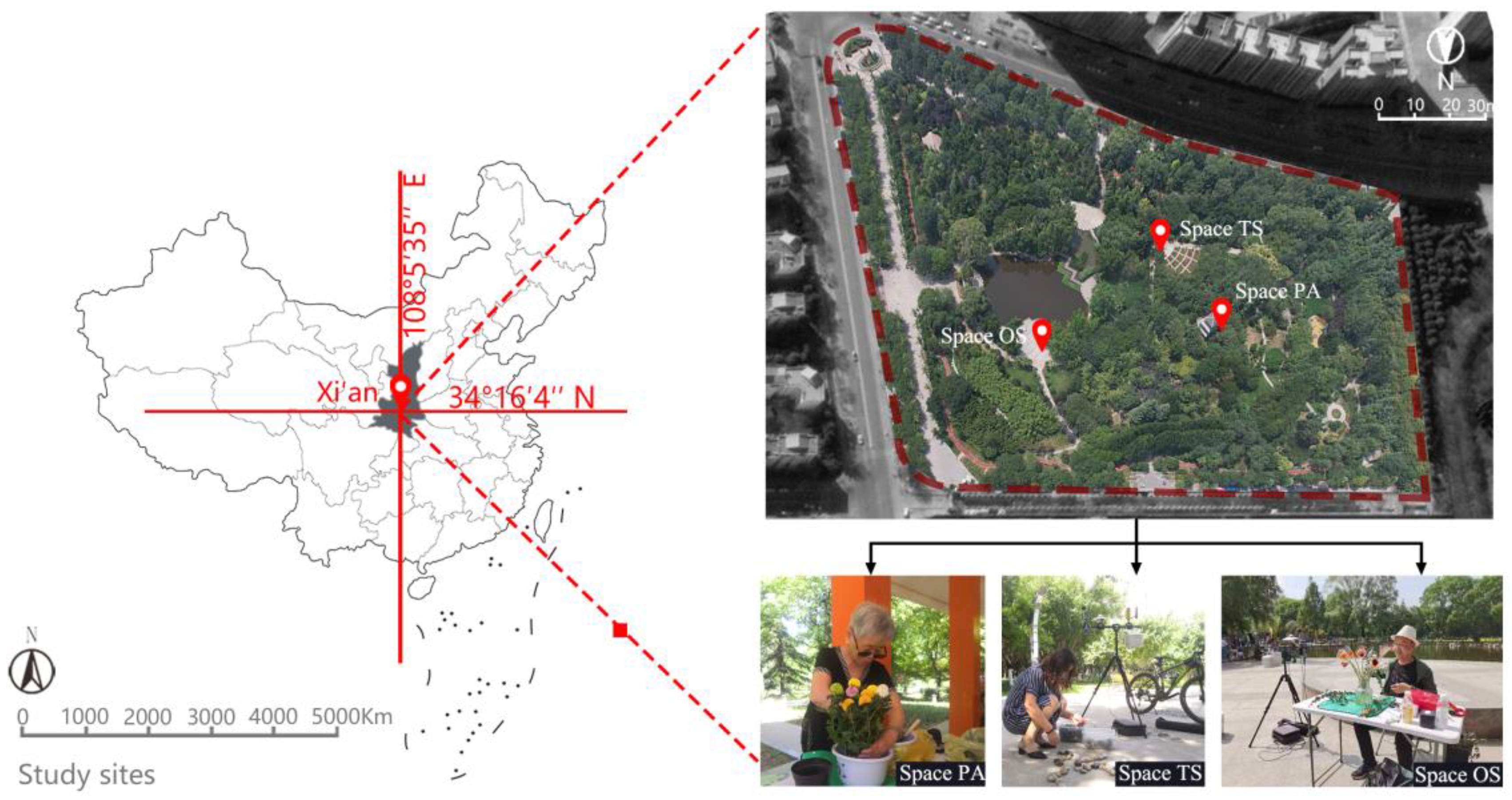



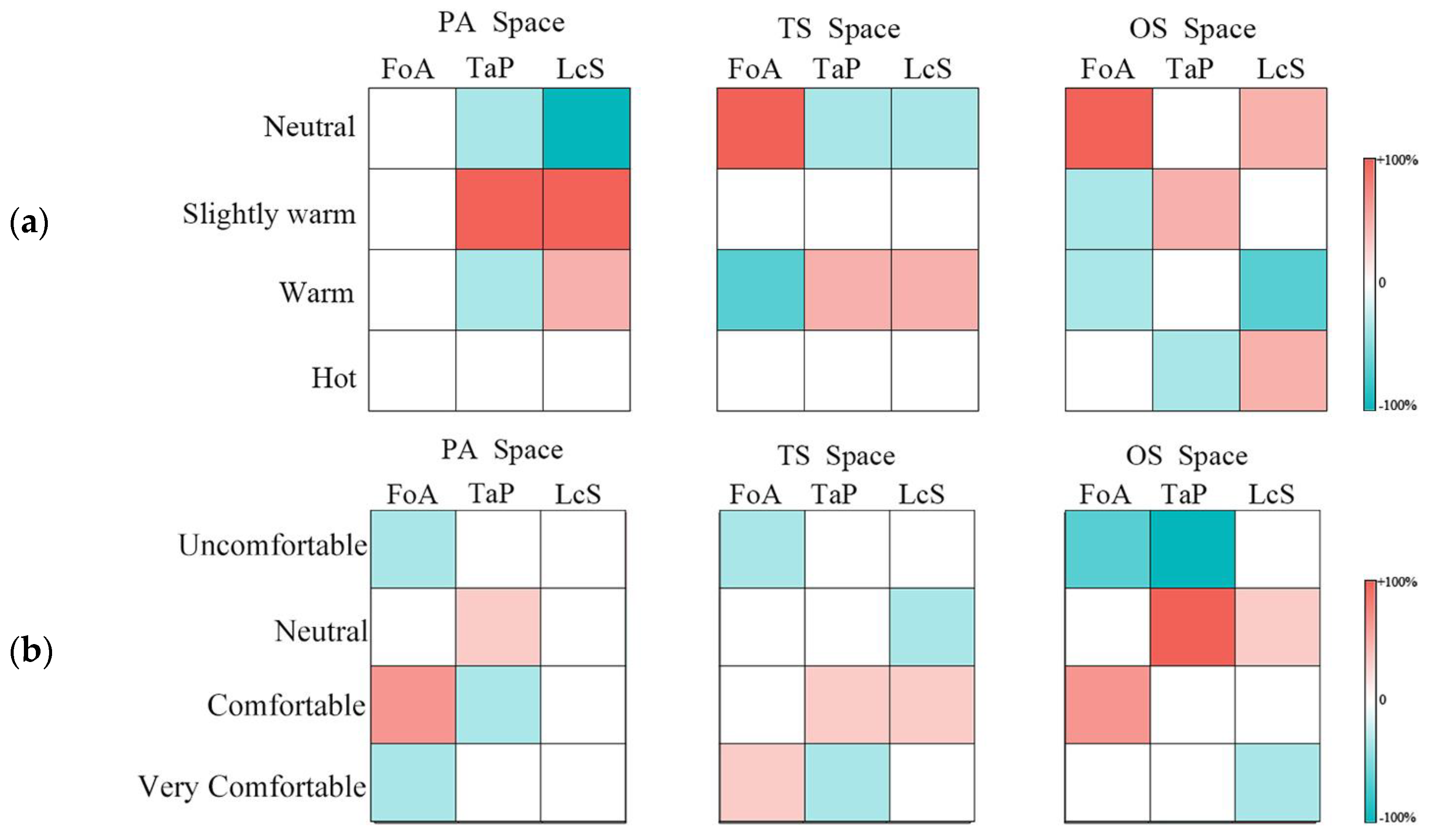
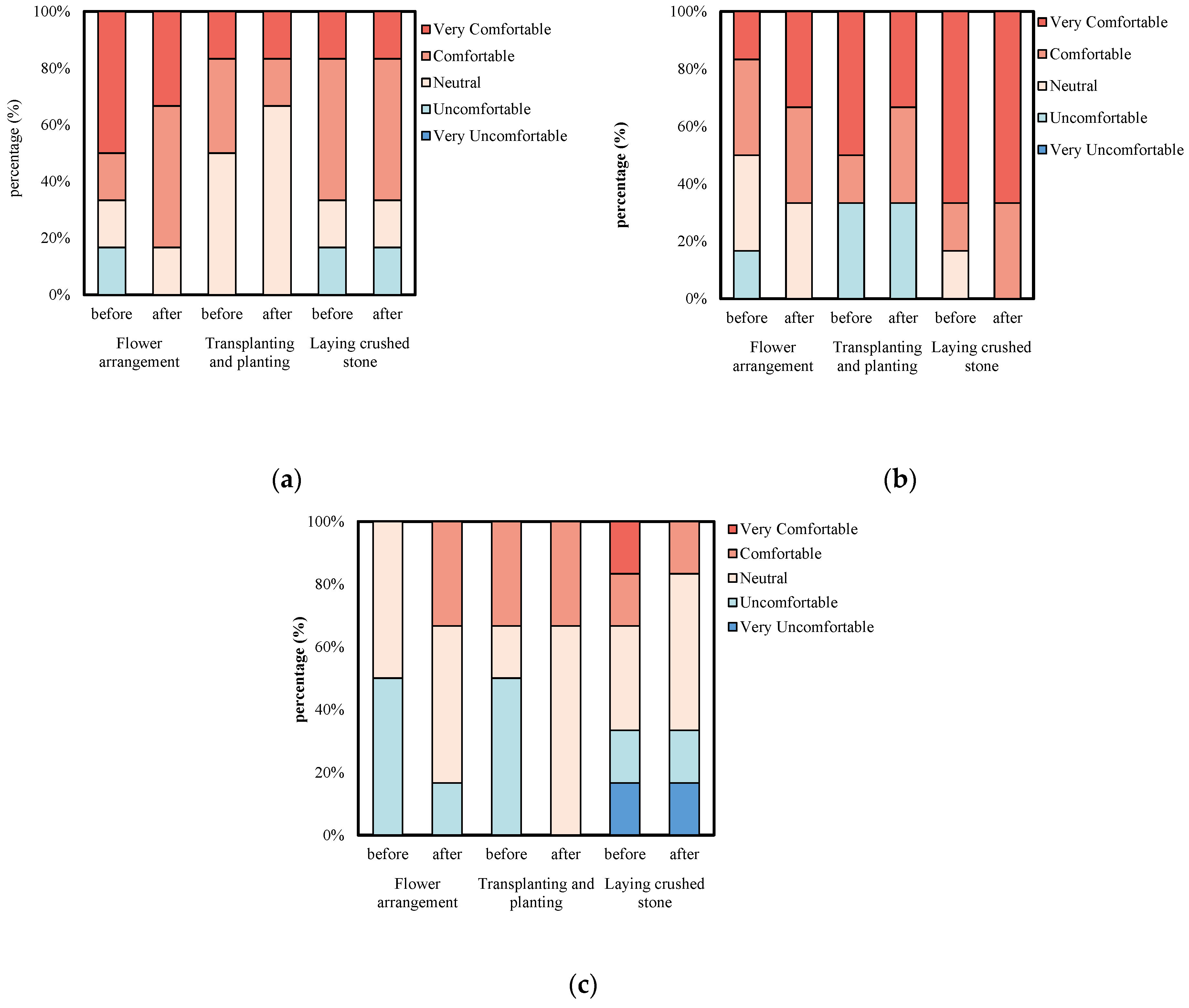
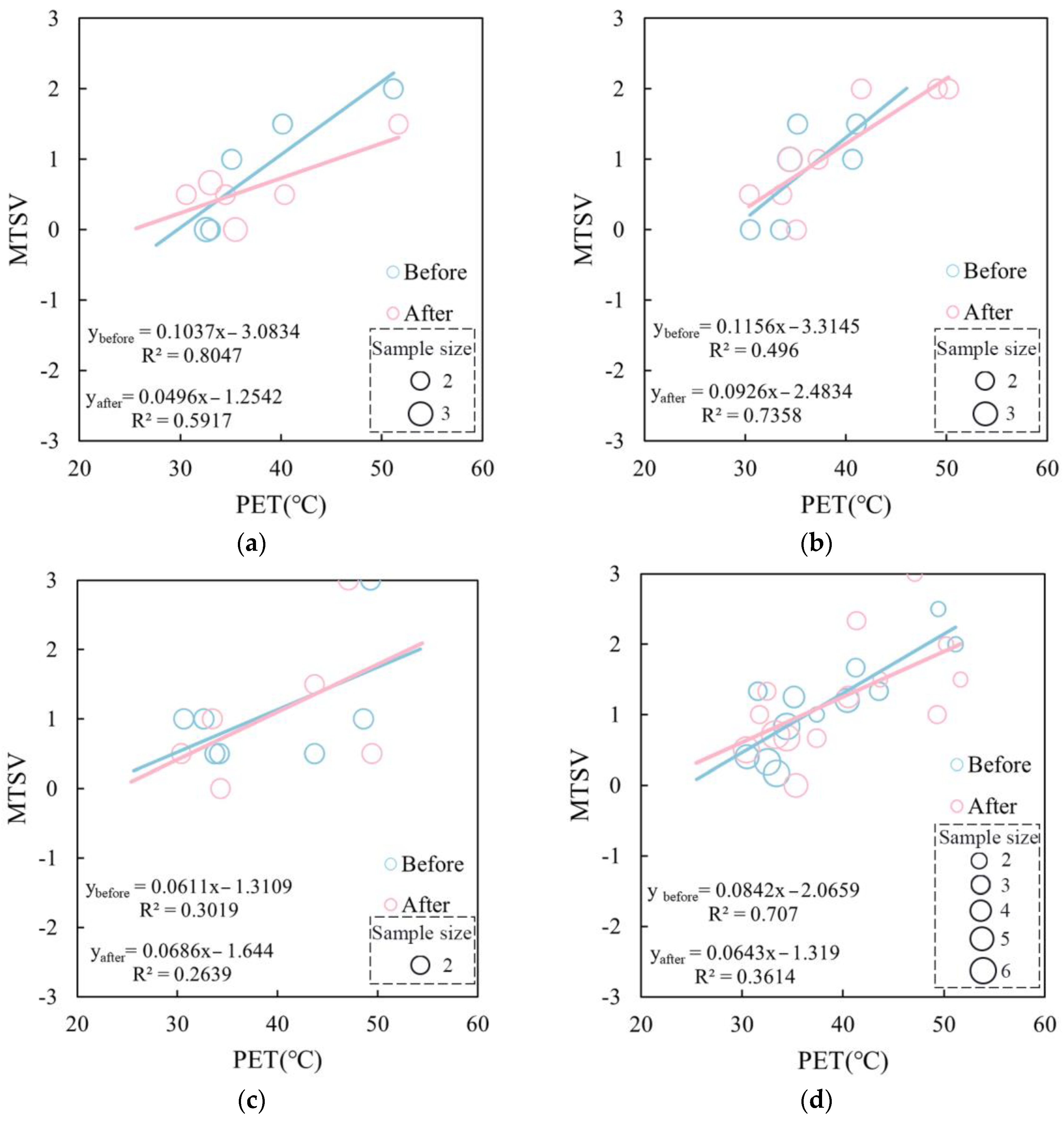
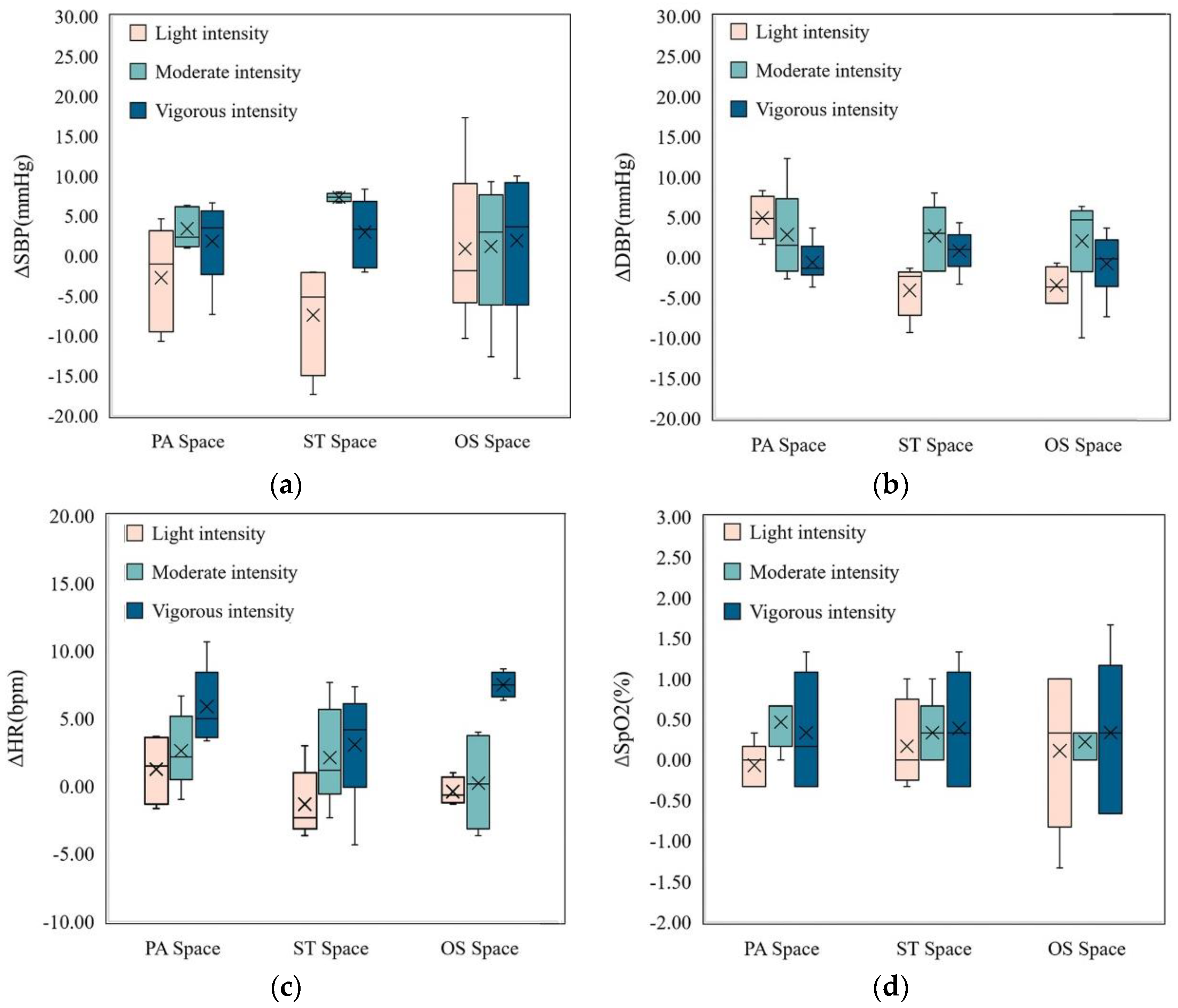
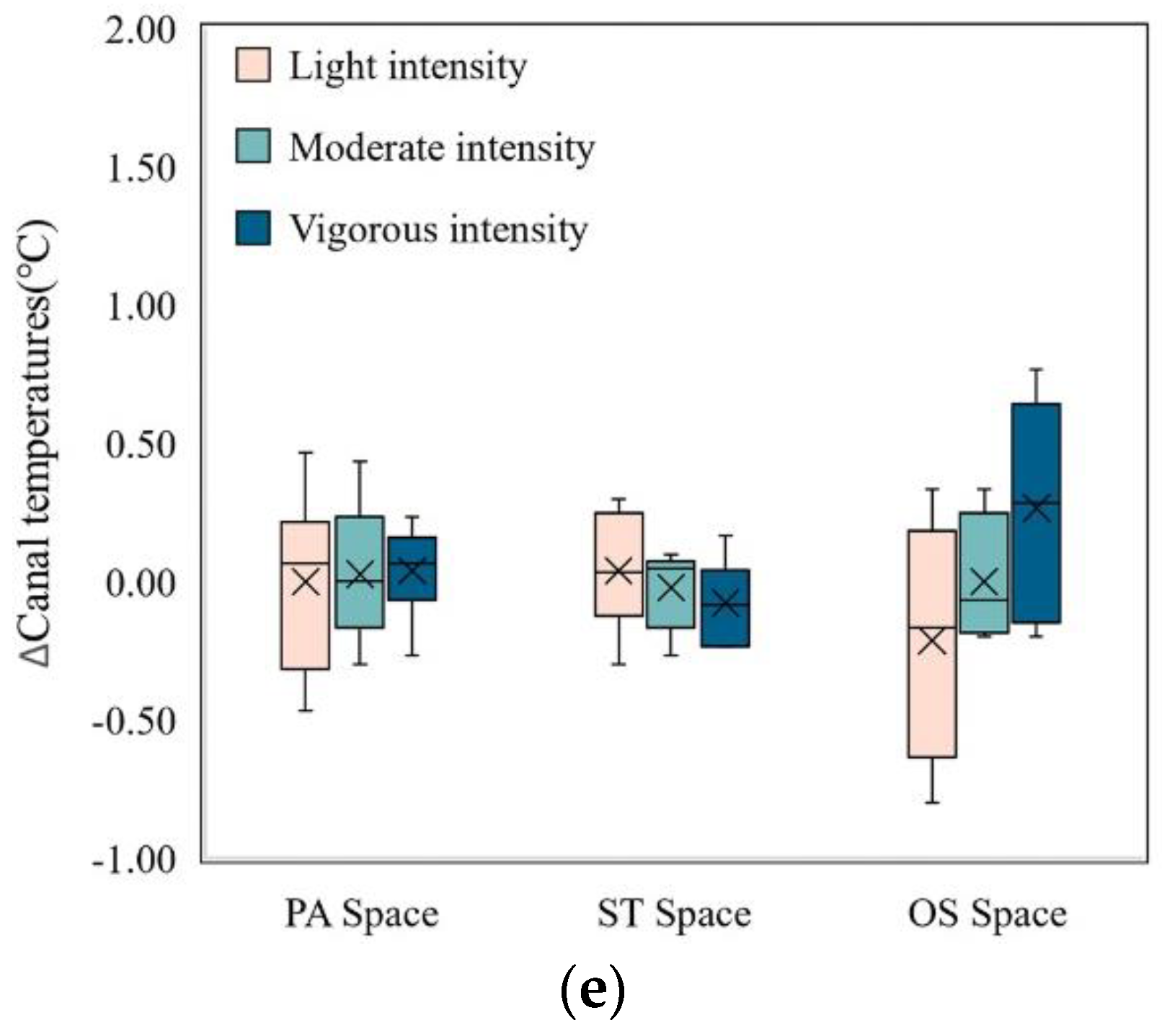
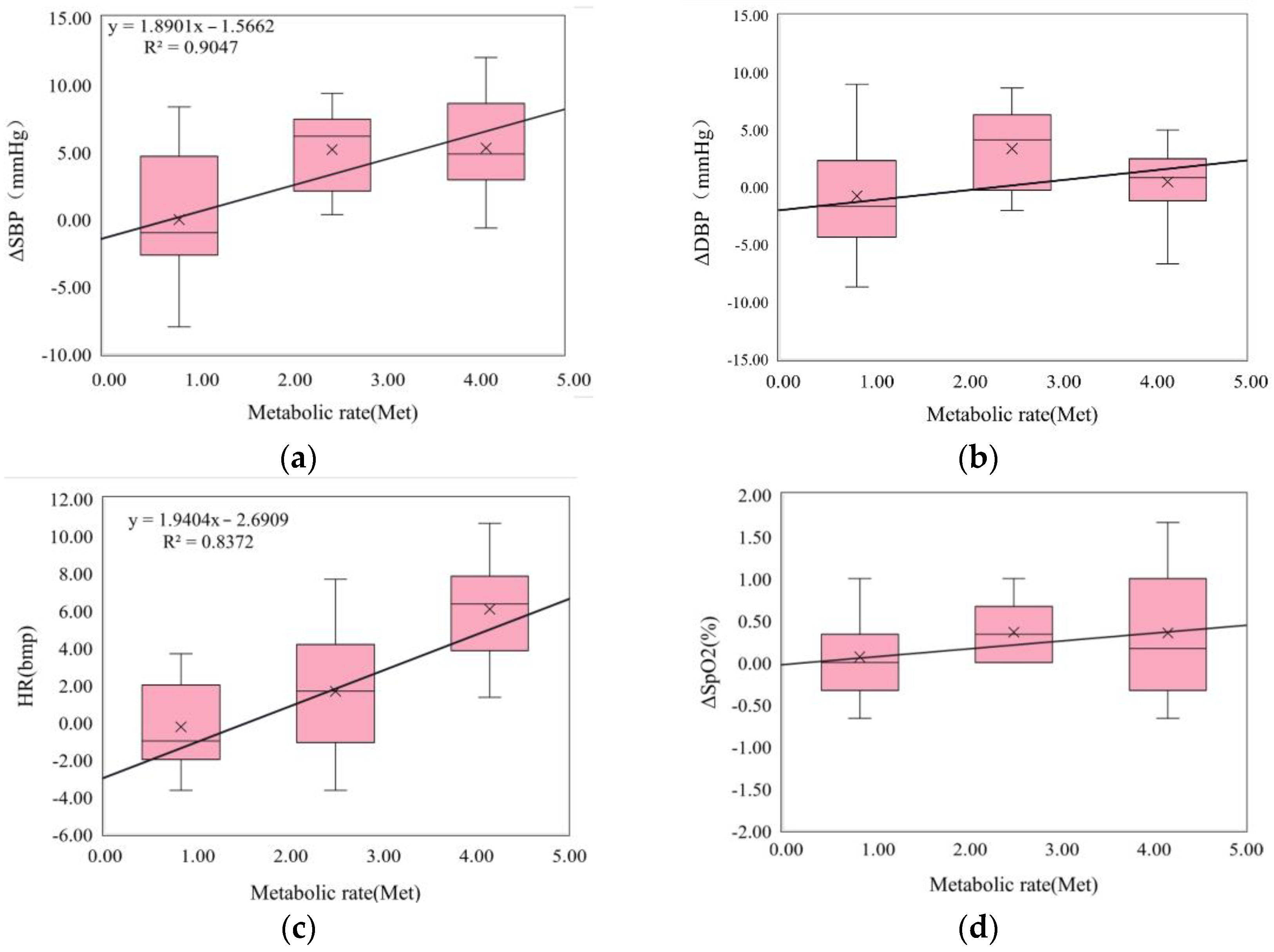
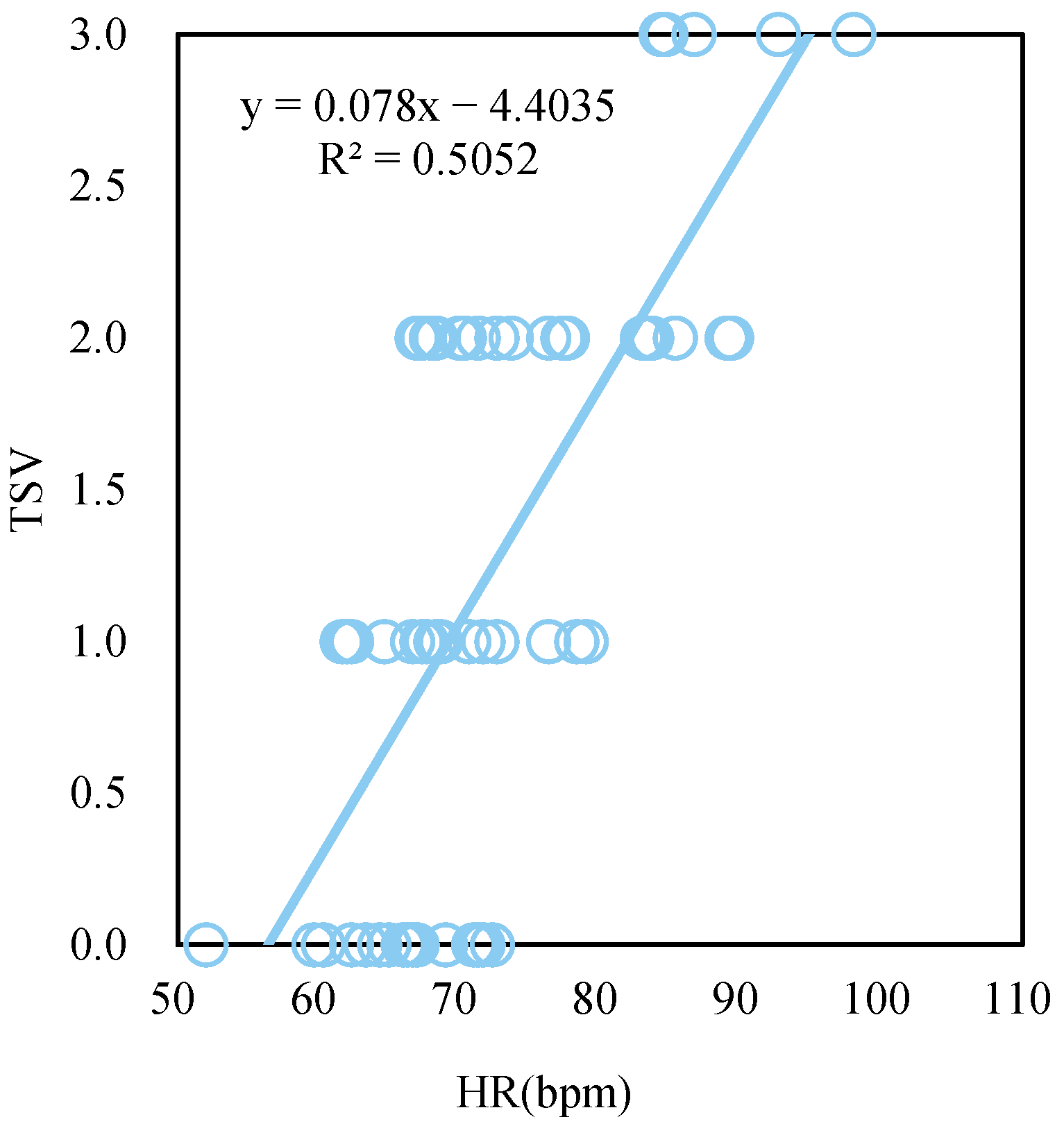


| Spaces | Main Characteristics | Fish-Eye Photos |
|---|---|---|
| Open Square (OS) | Hard-material-paved square. The south side is near the lake, the periphery of both east and west sides has street trees and resting seats, and the north side is adjacent to the park road. |  |
| SVF = 0.472 | ||
| Tree shade space (TS) | Located at the intersection of the park road, surrounded by street trees, with a shrub garden and small square in the northwest, trees planted densely in the northeast, and compound mixed-plant communities in the south. |  |
| SVF = 0.166 | ||
| Pavilion shade space (PA) | A three-story concrete structure building, situated on a small hill, surrounded by plants dominated by trees and bordered by a park road on the west side, with strong shading. |  |
| SVF = 0.001 |
| Instrumentation | Parameter | Range | Accuracy |
|---|---|---|---|
| OMRON HEM–7211 | Blood pressure | 0–299 mmHg | ±3 mmHg |
| Heart rate | 40–180 bmp | ±2 bmp | |
| PHILIPS DB12 | Blood oxygen saturation | 35–100% | ±2% |
| Braun Thermo Scan*Infrared Ear Thermometer IRT6520 | Ear canal temperature | 34–42.2 °C | ±0.1 °C |
| HOBO onset U23-001 | Air temperature | −40–70 °C | ±0.21 °C |
| Relative humidity | 0–100% | ±2.5% | |
| Kestrel 5500 | Wind speed | 0–40 m/s | 0.1 m/s |
| Delta OHM HD 2107.2 | Globe temperature | −30–120 °C | ±0.25 °C |
| JTR05 | Global radiation | 0–2000 W/m2 | ≤±2% |
| Gender | |||
| Male | 14(26%) | ||
| Female | 40(74%) | ||
| Age | Weight (kg) | ||
| Max | 86.0 | Max | 96.0 |
| Min | 60.0 | Min | 44.0 |
| Mean ± SD | 66.6 ± 5.8 | Mean ± SD | 62.5 ± 10.6 |
| Height (cm) | Clothing insulation (Clo) | ||
| Max | 180.0 | Max | 1.3 |
| Min | 156.0 | Min | 0.2 |
| Mean ± SD | 163.5 ± 5.8 | Mean ± SD | 0.5 ± 0.2 |
| Model 1: Thermal Sensation | Model 2: Thermal Comfort | Model 3: Thermal Acceptability | ||||
|---|---|---|---|---|---|---|
| Individual factors | Estimate | Sig | Estimate | Sig | Estimate | Sig |
| Age | −0.012 | 0.787 | −0.007 | 0.877 | 21.063 | 0.998 |
| BMI | −0.084 | 0.219 | 0.122 | 0.081 | −0.024 | 0.884 |
| Clothing insulation | −0.795 | 0.593 | −4.926 | 0.004 ** | 0.384 | 0.418 |
| Gender | 0.576 | 0.354 | −0.596 | 0.335 | 18.377 | 0.076 |
| PA Space | TS Space | OS Space | ||
|---|---|---|---|---|
| Ta (°C) | Max | 34.0 | 34.3 | 36.5 |
| Min | 28.6 | 28.7 | 30.5 | |
| Mean ± SD | 31.7 ± 1.5 | 32.1 ± 1.6 | 33.8 ± 1.6 | |
| RH (%) | Max | 65.6 | 66.6 | 61.6 |
| Min | 41.3 | 38.8 | 37.1 | |
| Mean ± SD | 51.7 ± 5.9 | 50.2 ± 6.3 | 46.5 ± 5.8 | |
| Va (m/s) | Max | 0.8 | 0.9 | 0.8 |
| Min | 0.0 | 0.1 | 0.1 | |
| Mean ± SD | 0.2 ± 0.2 | 0.5 ± 0.2 | 0.5 ± 0.2 | |
| Tg (°C) | Max | 34.9 | 45.0 | 48.5 |
| Min | 29.1 | 30.8 | 32.9 | |
| Mean ± SD | 32.4 ± 1.5 | 37.1 ± 3.6 | 42.0 ± 4 | |
| G (W/m2) | Max | 35.3 | 735.1 | 903.5 |
| Min | 6.5 | 92.8 | 66.9 | |
| Mean ± SD | 18.9 ± 9.2 | 266.8 ± 166 | 542.3 ± 255.5 | |
| Tmrt (°C) | Max | 36.7 | 63.6 | 70.8 |
| Min | 29.1 | 33.7 | 34.5 | |
| Mean ± SD | 33.2 ± 2 | 46.2 ± 8.6 | 54.7 ± 10.5 |
| Variable | Sum of Squares | df | Mean Square | F | Sig. | |
|---|---|---|---|---|---|---|
| Ta | Between Groups | 3144.166 | 2 | 1572.083 | 629.561 | 0.000 |
| Within Groups | 9454.054 | 3786 | 2.497 | |||
| Total | 12,598.22 | 3788 | ||||
| RH | Between Groups | 17,837.236 | 2 | 8918.618 | 247.605 | 0.000 |
| Within Groups | 136,370.033 | 3786 | 36.02 | |||
| Total | 154,207.27 | 3788 | ||||
| Va | Between Groups | 83.353 | 2 | 41.677 | 927.421 | 0.000 |
| Within Groups | 170.136 | 3786 | 0.045 | |||
| Total | 253.489 | 3788 | ||||
| G | Between Groups | 173,046,249.8 | 2 | 86,523,124.9 | 2801.955 | 0.000 |
| Within Groups | 116,879,099.5 | 3785 | 30,879.551 | |||
| Total | 289,925,349.3 | 3787 | ||||
| Tg | Between Groups | 58,312.125 | 2 | 29,156.062 | 2817.19 | 0.000 |
| Within Groups | 39,182.614 | 3786 | 10.349 | |||
| Total | 97,494.739 | 3788 | ||||
| Tmrt | Between Groups | 295,118.036 | 2 | 147,559.018 | 2359.036 | 0.000 |
| Within Groups | 236,816.402 | 3786 | 62.551 | |||
| Total | 531,934.438 | 3788 | ||||
| Number | Equation | PET = 20 °C | PET = 30 °C | PET = 37.53 °C |
|---|---|---|---|---|
| MTSVBH | MTSVBH = 0.0842PET − 2.0659 | −0.38 | 0.46 | 1.09 |
| MTSVAH | MTSVAH = 0.0643PET − 1.319 | −0.033 | 0.61 | 1.09 |
| ΔMTSV | ΔMTSV = 0.0199PET − 0.747 | −0.349 | −0.15 | 0 |
| Horticultural Activities | NPET (°C) | NPETR (°C) | ||
|---|---|---|---|---|
| Before | After | Before | After | |
| Flower arrangement | 29.73 | 25.29 | 24.91–34.56 | 15.21–35.37 |
| Transplanting and planting | 28.67 | 26.82 | 24.35–33.0 | 21.42–32.22 |
| Laying crushed stone | 21.45 | 23.97 | 13.27–29.64 | 16.68–31.25 |
| Total | 24.54 | 20.51 | 18.60–30.47 | 12.74–28.29 |
| Before VS After | Light Intensity | Moderate Intensity | Vigorous Intensity |
|---|---|---|---|
| SBP | 0.768 | 0.002 ** | 0.004 ** |
| DBP | 0.635 | 0.047 * | 0.793 |
| HR | 0.891 | 0.046 * | 0.000 ** |
| SpO2 | 0.135 | 0.001 ** | 0.069 |
| Ear Canal temperatures | 0.945 | 0.737 | 0.272 |
| TSV | TCV | PET | ||||
|---|---|---|---|---|---|---|
| Physiological Parameters | Pearson Correlation | Sig. | Pearson Correlation | Sig. | Pearson Correlation | Sig. |
| HR | −0.304 | 0.021 * | 0.054 | 0.687 | 0.209 | 0.030 * |
| SBP | 0.172 | 0.198 | −0.082 | 0.541 | −0.076 | 0.433 |
| DBP | −0.016 | 0.906 | 0.021 | 0.873 | 0.040 | 0.680 |
| SpO2 | 0.192 | 0.149 | −0.326 * | 0.113 | 0.218 | 0.024 * |
| Ear canal temperatures | 0.238 | 0.172 | −0.124 | 0.353 | 0.062 | 0.526 |
| Spaces | Advantages and Disadvantages | Expected Activity Intensity | Design Strategies |
|---|---|---|---|
| PA | Low T; Low Va, High RH | Light and moderate-intensity activities | Appropriate thinning of surrounding shrubs and evergreen trees, planting deciduous mosquito-repellent trees |
| TS | High Va; High Ta, Low RH | All | Adding structures (corridors) and sprinklers to improve the thermal environment |
| OS | High Va; High Ta, Low RH and shade | Light and moderate-intensity activities | Adding movable awnings, sprinkler irrigation facilities, and replanting deciduous trees to regulate the thermal environment. Furthermore, adding sprinkler irrigation facilities to the surrounding grass to achieve cooling and humidifying effects |
Disclaimer/Publisher’s Note: The statements, opinions and data contained in all publications are solely those of the individual author(s) and contributor(s) and not of MDPI and/or the editor(s). MDPI and/or the editor(s) disclaim responsibility for any injury to people or property resulting from any ideas, methods, instructions or products referred to in the content. |
© 2023 by the authors. Licensee MDPI, Basel, Switzerland. This article is an open access article distributed under the terms and conditions of the Creative Commons Attribution (CC BY) license (https://creativecommons.org/licenses/by/4.0/).
Share and Cite
Yuan, T.; Hong, B.; Li, Y.; Wang, Y.; Wang, Y. The Right Activities at Right Spaces: Relationships between Elderly Adults’ Physical Activities and Thermal Responses. Buildings 2023, 13, 721. https://doi.org/10.3390/buildings13030721
Yuan T, Hong B, Li Y, Wang Y, Wang Y. The Right Activities at Right Spaces: Relationships between Elderly Adults’ Physical Activities and Thermal Responses. Buildings. 2023; 13(3):721. https://doi.org/10.3390/buildings13030721
Chicago/Turabian StyleYuan, Tingting, Bo Hong, Yichen Li, Yanbo Wang, and Yayun Wang. 2023. "The Right Activities at Right Spaces: Relationships between Elderly Adults’ Physical Activities and Thermal Responses" Buildings 13, no. 3: 721. https://doi.org/10.3390/buildings13030721
APA StyleYuan, T., Hong, B., Li, Y., Wang, Y., & Wang, Y. (2023). The Right Activities at Right Spaces: Relationships between Elderly Adults’ Physical Activities and Thermal Responses. Buildings, 13(3), 721. https://doi.org/10.3390/buildings13030721







